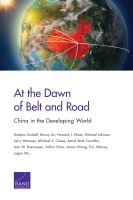| 来源类型 | Research Reports
|
| 规范类型 | 报告
|
| DOI | https://doi.org/10.7249/RR2273
|
| ISBN | 9780833099914
|
| 来源ID | RR-2273-A
|
| At the Dawn of Belt and Road: China in the Developing World |
| Andrew Scobell; Bonny Lin; Howard J. Shatz; Michael Johnson; Larry Hanauer; Michael S. Chase; Astrid Stuth Cevallos; Ivan W. Rasmussen; Arthur Chan; Aaron Strong; et al.
|
| 发表日期 | 2018
|
| 出版年 | 2018
|
| 页码 | 400
|
| 语种 | 英语
|
| 结论 |
China's involvement with the Developing World encompasses political and diplomatic, economic, and military dimensions- The Developing World offers China economic growth and global influence.
- Beijing has a growing challenge of protecting overseas citizens and investments.
- Southeast Asia is China's top priority economically and politically.
China's geostrategic relationships with pivotal states focus on anticipated bilateral and regional benefits- China sees benefits in Malaysia (economic), Indonesia (political), Thailand (trustworthiness), and Vietnam (geostrategic risk).
- Russia concentrates on military activities and shares China's interests in countering terrorism and Western ideas of democracy and human rights.
- Pakistan assists China in internal security.
- Iran offers China a friend not beholden to the United States.
- The Republic of South Africa has a strong financial sector and rule of law.
- Venezuela's oil deposits have been attractive.
Consequences of the Chinese strategy toward the Developing World for the United States- Washington and Beijing are contentious over Chinese activities in the South China Sea and China's insistence that U.S. military vessels and aircraft get permission prior to traversing disputed waters.
- Outside Southeast Asia, the United States and China appear to be partners in parallel: two states working separately with no collaboration but in pursuit of similar ends. Their relationship varies significantly by region.
- China is not an adversary but can harm U.S. global interests. A challenge remains as to whether and how to encourage China to act as a cooperative partner.
|
| 摘要 |
- Despite the fact that the United States and China are competitors around the globe and in specific regions, cooperation between the two nations is possible. Washington should look to cooperate with Beijing where interests coincide but must recognize that any cooperation will almost certainly be limited.
- Washington should appreciate that the degree of possible U.S.-China cooperation is likely to vary by region, with regions closest to China, such as Southeast Asia, more difficult. In contrast, cooperation with Beijing in regions further removed from China, such as the Middle East, is likely to be less difficult.
|
| 主题 | Association of Southeast Asian Nations
; China
; Developing Countries
; International Economic Relations
; Southeast Asia
; United States
|
| URL | https://www.rand.org/pubs/research_reports/RR2273.html
|
| 来源智库 | RAND Corporation (United States)
|
| 引用统计 |
|
| 资源类型 | 智库出版物
|
| 条目标识符 | http://119.78.100.153/handle/2XGU8XDN/108869
|
推荐引用方式
GB/T 7714 |
Andrew Scobell,Bonny Lin,Howard J. Shatz,et al. At the Dawn of Belt and Road: China in the Developing World. 2018.
|
|
文件名:
|
x1539697702057.jpg
|
|
格式:
|
JPEG
|

|
文件名:
|
RAND_RR2273.pdf
|
|
格式:
|
Adobe PDF
|
除非特别说明,本系统中所有内容都受版权保护,并保留所有权利。